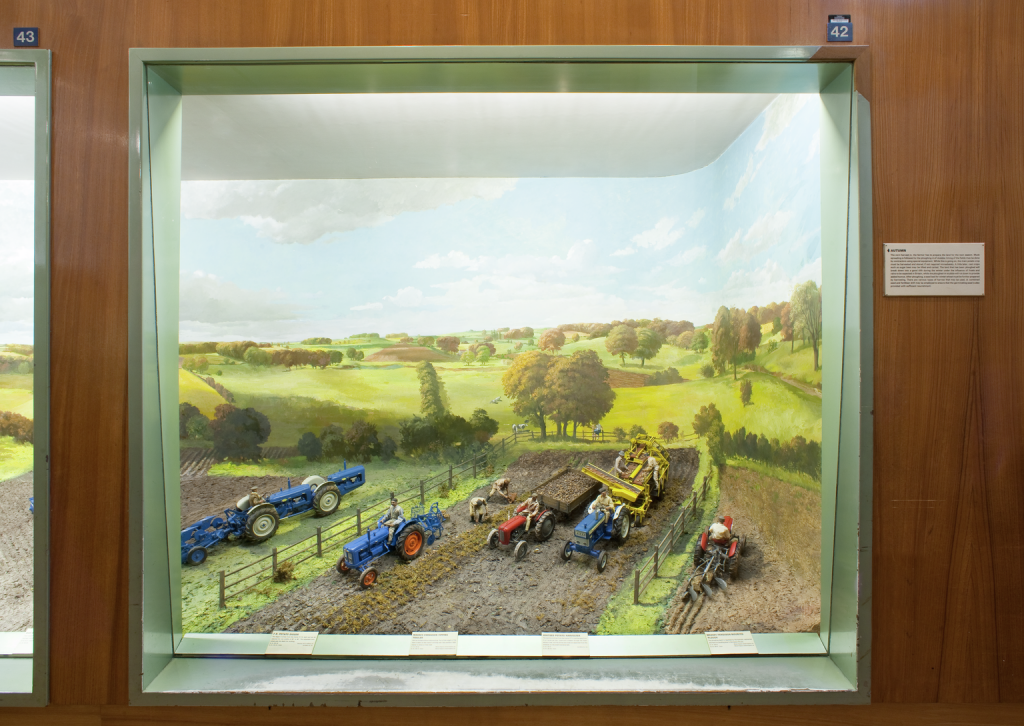It might take a small leap of imagination, but the Science Museum’s Agriculture Gallery was once a radical new visitor experience. Unveiled back in 1951, its detailed dioramas and hugely important prototypes of the latest machinery would have caused the same excitement as our new galleries do today.
Sixty five years ago William O’Dea, the gallery’s original curator, wanted to showcase the ‘immense strides… made in mechanization during and just after the war’. With rationing still in place, it’s not hard to see why people would be keen to see how new technologies were helping to dramatically increase food production in the UK – and putting an end to the back-breaking labour of the old ways.
This month (January 2017), the Museum’s pioneering Agriculture Gallery closed to make way for a stunning new suite of Medicine Galleries (opening in 2019). Meanwhile, behind the scenes, a new team of Science Museum curators are carrying out research for a contemporary agriculture gallery that will examine the challenges facing global food production today.
BBC presenter Tom Heap came to the Museum to celebrate the original gallery, which was one of the first to use dioramas on a major scale, vividly presenting the latest agricultural machinery at work in traditional farm settings.
David Matless, Professor of Cultural Geography at the University of Nottingham, is interested in what the old gallery tells us about how we used to live:
“These dioramas represent time capsules of mid-20th century environmental attitudes… The old gallery was a celebration of farming and its productivity… although now to us it looks very much like something from the past”.
Horses were still common on farms in 1951, so the tractors and combine harvesters on display represented the radically ambitious future.

Today’s farmers still rely on science and technology for new ways to farm the land and they are producing more food per person than ever before. But now we also want to preserve biodiversity, ecosystems and natural resources, reduce our impact on the environment, and ensure that future generations can produce food too.
The new agriculture gallery will show how farmers are working with scientists and engineers in the 21st century to achieve this balance – feeding over 7 billion people every day, and managing our growing social and environmental concerns.
With the Science Museum Group’s collection of more than seven million objects, new acquisitions from modern farms, as wells as prototypes and models from cutting-edge researchers, the new gallery will look to the past, present and future to tell the story of agriculture.
We are working hard to make sure it will delight our visitors every bit as much as its predecessor.
Written by Mary Cavanagh, Senior Content Developer for the Contemporary Agriculture gallery and Julia Murray, PR Manager.
2 comments on “Celebrating the past, present and future of agriculture”
Comments are closed.
Alright, I’m biased, but I thought it was brilliant.
Hello Mary,
I’ve just seen the Tom Heap film via FB – I look forward to seeing the new Agriculture gallery when it’s ready and wish you all the very best in creating it with your team.
Can you tell me please if the models in the dioramas are accessioned?
My husband, Steve Allman, and I met when we both worked at the Science Museum in the 1990s. For an obvious reason I’d really like to have the model of the Allman High Low Volume Sprayer if it is going to disposed of. We have very fond memories and some lifelong friends made during our time at SciM, and the hilarity of Steve having his very own crop sprayer on display is one of them! He used to take visitors to see it and claim it was invented by a relative (it wasn’t…).
I’d hate to think of it being thrown out, but obviously understand if it is part of the collection and will be going into storage.
I look forward to hearing from you.
Best wishes
Sarah Allman